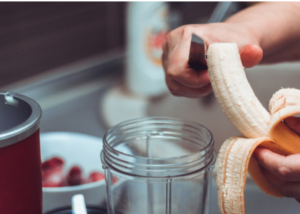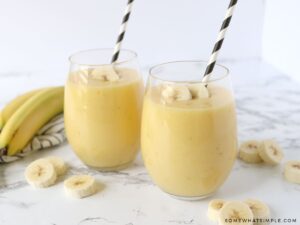The fitness industry has long been plagued by fear-mongering tactics that prey on individuals’ anxieties about weight loss and health. Recently, an episode of Joe Rogan’s podcast sparked controversy when comedian Joey Diaz claimed that blending bananas, as opposed to eating them whole, was “killing you” and contributing to weight gain.
Let’s dive into Joey’s claim and break it down. In the interview with Rogan, Diaz states that he blended a banana into coconut milk and saw that he gained weight that week. He surmises that the only thing which changed in his nutritional habits was the eating of the banana. “When you drink fruit and when you eat fruit, it’s two different things… when you eat fruit, the saliva in your mouth breaks the fruit down, and you digest the sugar a different way,” Diaz argues. He furthers his argument by stating that individuals who drink fruit smoothies are “fatter” than individuals who eat fruit whole.

Before addressing the claim that blended bananas are “killing yourself,” we should talk about the fear-mongering tactics employed by such statements, emphasizing the use of exaggerated and emotionally charged language without providing credible, evidence-based information. The oversimplification of the relationship between food and health is a common tactic in fear-mongering, as complex topics like nutrition and weight management, cannot be reduced to a single food item or preparation method.
Fear-mongering has become pervasive in the fitness industry for several compelling reasons. Firstly, sensationalized claims and exaggerated language tend to grab attention, generating more clicks, views, and social media interactions. In an age where online engagement is heavily monetized, fear-based content becomes a powerful tool for attracting audiences. The urgency and anxiety induced by fear-mongering can also lead individuals to seek quick fixes or miracle solutions, making them more susceptible to marketing tactics. Moreover, the complexity of health and fitness is often oversimplified to fit into easily digestible narratives, making fear-driven messages more accessible and shareable. The competitive nature of the industry, coupled with the desire for rapid success, further fuels the prevalence of fear-based tactics as fitness influencers and media outlets vie for attention in a crowded digital landscape. Ultimately, the pairing of fear and online visibility creates a symbiotic relationship that benefits content creators, even if it comes at the cost of perpetuating misleading or harmful information.

As fear-mongering continues to dominate the fitness industry landscape, it’s imperative to dissect such sensationalized claims and turn to credible sources for nuanced insights. I’ve recruited Natalie Adair Suazo, Fitbliss Fitness’ Chief Science Officer, to provide a thoughtful analysis, research-based perspective that debunks the fear-driven narratives circulating in the realm of health and nutrition.
“In this instance, implying that blending a banana is inherently harmful or fattening, it really just ignores this broader context,” Suazo argues, “The statement completely lacks any sort of context or nuance. It also suggests that eating a whole banana is the only acceptable way to consume this food for weight loss. So again, it’s failing to consider any sort of individual needs at all.”
This discussion extends beyond the nutritional aspect, addressing the psychological and behavioral aspects of eating. First, let’s talk about satiety. “We know that when we eat whole foods, in this example, eating a whole banana, when we’re chewing something, when we are tasting the flavors, and we’re smelling the banana and taking our time and being really immersed into this experience, chewing is going to take a lot longer than just quickly drinking a smoothie,” said Natalie. “Chewing is going to allow our brain to have a signal triggered that we are eating.” The mechanisms of satiety contributes to a sense of fullness. In contrast, liquid forms of food, like smoothies, may lead to overeating as they lack the same level of satisfaction.
Second, we need to consider fiber content. Dietary fiber is essential for regulating our digestion and allowing us to feel fuller, longer. It’s recommended that most individuals consume about 25g of fiber each day. A whole banana has about 3g of fiber, so it’s a relatively fiber-rich food. Natalie explains how blending the banana can impact fiber intake and our feelings of fullness, “While blending the banana does retain some of the fiber from the fruit, it often removes or reduces the overall content. So this might leave us feeling hungry sooner.” Meaning that blending a banana may, in turn, cause us to eat more later on in the day due to lowered feelings of fullness.
 Joey Diaz’s assertion that blending bananas is a culprit for weight gain oversimplifies a complex issue, as various factors contribute to changes in body weight. One significant aspect is that smoothies typically incorporate various ingredients, such as sweeteners, yogurt, almond milk, peanut butter, and oats, which can significantly increase the overall calorie content compared to a standalone banana. Diaz’s choice to attribute weight gain solely to blended bananas disregards the broader dietary context, including the total calorie intake and the variety of ingredients in his smoothie breakfast. It serves as a reminder that weight management is a multifaceted endeavor influenced by numerous factors beyond the method of consuming a single food item.
Joey Diaz’s assertion that blending bananas is a culprit for weight gain oversimplifies a complex issue, as various factors contribute to changes in body weight. One significant aspect is that smoothies typically incorporate various ingredients, such as sweeteners, yogurt, almond milk, peanut butter, and oats, which can significantly increase the overall calorie content compared to a standalone banana. Diaz’s choice to attribute weight gain solely to blended bananas disregards the broader dietary context, including the total calorie intake and the variety of ingredients in his smoothie breakfast. It serves as a reminder that weight management is a multifaceted endeavor influenced by numerous factors beyond the method of consuming a single food item.
Ultimately, Suazo concludes that whether one chooses to eat a whole banana or blend it into a smoothie should depend on individual taste preferences and lifestyle. Both options, she argues, can be part of a balanced and healthy diet, and that blending bananas as opposed to eating them whole is not “killing yourself.”
This thoughtful analysis serves as a crucial reminder to approach nutrition advice with a critical mindset, steering clear of fear-based tactics that oversimplify complex topics and may contribute to unnecessary anxiety in the pursuit of a healthy lifestyle.
We encourage each of you to be skeptical of such claims in the absence of scientific evidence. “There’s no scientific evidence to support this idea that blending a banana or any sort of food item is lethal or the sole cause of something like weight gain,” stated Natalie.

Leave a Comment